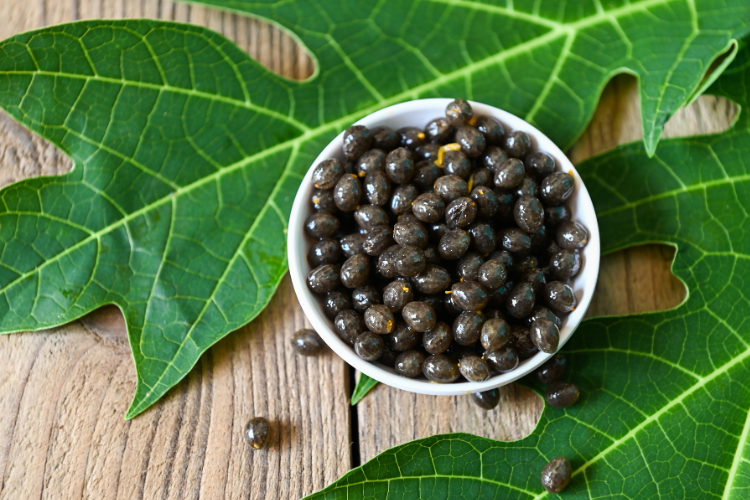Blog
The Secrets of Young Papaya Leaves
Green young papaya leaves have gained attention for their numerous health benefits. This blog delves into the origins of green papaya leaves, the science behind their potency, and provides insights into their culinary applications.
1. Traditional Uses of Papaya Leaves
Papaya leaves have a rich history of traditional uses across various cultures. Let’s take a trip around the globe to explore how different societies have incorporated papaya leaves into their traditional practices.
Ayurveda in India
In traditional Ayurvedic medicine, these leaves are revered for their digestive properties. They are often used to make a concoction believed to aid in digestion and treat digestive disorders. Additionally, the leaves are used for their anti-inflammatory properties to alleviate conditions such as arthritis.
Philippines & Indonesia and Dengue Fever
In the Philippines and Indonesia, papaya leaves have gained recognition for their potential role in managing dengue fever. It is a common practice to extract the juice from papaya leaves, as some studies suggest it may help increase platelet count, which is crucial for those suffering from dengue.
Southeast Asia – Culinary Uses
Across Southeast Asia, especially in Thai and Indonesian cuisines, these leaves are incorporated into salads and traditional dishes. The leaves are finely shredded and mixed with various herbs, spices, and sauces to create a flavorful and nutritious dish.
Traditional Medicine in Nigeria
In Nigeria and other parts of West Africa, these leaves are used in traditional medicine to address a variety of health issues. The leaves are often brewed into a tea and consumed to treat malaria, as they are believed to possess anti-malarial properties.
Caribbean and Healing Poultices
In the Caribbean, papaya leaves are sometimes used to make healing poultices. Crushed leaves are applied topically to wounds or skin conditions to promote healing and alleviate inflammation.
Latin American Folk Medicine
Various Latin American cultures incorporate papaya leaves into traditional folk medicine. They are believed to have diuretic properties and are used to promote kidney health. Additionally, the leaves are sometimes applied externally to treat skin conditions.
Folk Remedies in Sri Lanka
In Sri Lanka, these leaves are traditionally used as a remedy for digestive issues. The juice extracted from the leaves is consumed to alleviate constipation and promote a healthy digestive system.
Traditional Chinese Medicine (TCM)
In Traditional Chinese Medicine, these leaves are used for their detoxifying properties. They are believed to help cleanse the liver and improve digestion. Papaya leaf tea is a common preparation in TCM for these purposes.
These traditional uses highlight the versatility of papaya leaves, not only as a culinary ingredient but also as a valuable component in traditional medicine across diverse cultures. While scientific research continues to explore the validity of some of these traditional practices, there’s no denying the cultural significance and long-standing history of incorporating papaya leaves into various aspects of health and well-being.
2. Health Benefits
1. Enzymatic Richness
Papaya leaves are renowned for their enzymatic richness, primarily attributed to the presence of papain and chymopapain. These enzymes contribute to the various health benefits associated with papaya leaves. Let’s delve into the scientific evidence supporting the enzymatic content of these leaves.
Papain is a proteolytic enzyme, meaning it breaks down proteins into smaller peptides or amino acids. A study published in the “Journal of Agricultural and Food Chemistry” in 2008 investigated the enzyme activities in different parts of the papaya plant, including the leaves. The study confirmed the presence of papain in significant amounts in papaya leaves.
Chymopapain is another proteolytic enzyme with similar protein-digesting properties to papain. Research published in the “Journal of Natural Products” in 1980 focused on the isolation and characterization of chymopapain from papaya leaves (see this article here). Chymopapain has been recognized for its potential therapeutic applications, particularly in the field of medicine, as it can break down and remove degenerated or herniated disc material in spinal surgery (see here).
Scientific studies have consistently confirmed the presence of papain and chymopapain in papaya leaves. These enzymes play a crucial role in protein digestion and have been the subject of research exploring their potential therapeutic applications, including anti-inflammatory properties and medical uses in conditions such as spinal surgery.
2. Platelet Count Enhancement
The potential platelet count enhancement effect of these leaves, especially in the context of managing diseases like dengue fever, has been a subject of scientific investigation.
Study on Dengue Patients: A study published in the “Asian Pacific Journal of Tropical Biomedicine” in 2013 investigated the effect of papaya leaf juice on platelet count in patients with dengue fever. The study involved 80 dengue patients, and the results showed a significant increase in platelet count among those who consumed papaya leaf juice compared to the control group.
The researchers concluded that papaya leaf juice could be considered an effective and low-cost treatment to increase platelet count in dengue patients.
Animal Studies: An animal study published in the “Journal of Pharmacognosy and Phytochemistry” in 2014 explored the potential of papaya leaf extract in increasing platelet count in thrombocytopenic rats. The study reported a significant elevation in platelet count in the rats treated with papaya leaf extract.
This animal study supports the idea that papaya leaf extracts may have a positive impact on platelet count, although further research is needed to understand the mechanisms involved.
Scientific evidence suggests a potential positive effect of papaya leaf juice and extract on platelet count, particularly in the context of dengue fever.

3. Antioxidant Properties
The antioxidant benefits of these leaves are attributed to the presence of various bioactive compounds, including flavonoids, polyphenols, and other phytochemicals. Antioxidants play a crucial role in neutralizing harmful free radicals in the body, thereby protecting cells from oxidative stress.
Flavonoids
A study published in the “International Journal of Pharmaceutical Sciences and Research” in 2015 investigated the antioxidant properties of papaya leaf extract. The study reported the presence of flavonoids and highlighted their role in scavenging free radicals.
Flavonoids, such as quercetin and kaempferol, are known for their antioxidant activities and are found in varying concentrations in papaya leaves.
Polyphenols
Research published in the “Journal of Medicinal Food” in 2011 identified polyphenols in papaya leaf extract and demonstrated their antioxidant and anti-inflammatory properties.
Polyphenols are recognized for their ability to combat oxidative stress and contribute to overall cellular health.
Carotenoids
Papaya leaves contain carotenoids, including beta-carotene, which is a potent antioxidant. A study published in “Food Chemistry” in 2011 highlighted the presence of beta-carotene in papaya leaves and its contribution to antioxidant activity.
Carotenoids are known for their ability to neutralize free radicals and protect cells from oxidative damage.
Scientific evidence supports the antioxidant benefits of these leaves, attributed to the presence of flavonoids, polyphenols, carotenoids, and other bioactive compounds. Antioxidants play a crucial role in maintaining cellular health by neutralizing free radicals, which are implicated in various chronic diseases and aging.
4. Immune System Support
The immune system support benefits of these leaves can be attributed to their rich content of vitamins, particularly vitamin A, vitamin C, and vitamin E, as well as other bioactive compounds. :
Vitamin A
Papaya leaves are a good source of vitamin A, which plays a crucial role in maintaining the health of the immune system. Vitamin A is essential for the proper functioning of immune cells and the integrity of mucosal surfaces, such as the lining of the respiratory and gastrointestinal tracts
Vitamin C
Papaya leaves are rich in vitamin C, a potent antioxidant known for its immune-enhancing properties. Vitamin C supports the production and function of white blood cells, which are key components of the immune system.
Vitamin E
Vitamin E, found in these leaves, contributes to the overall antioxidant defense in the body. Antioxidants help protect immune cells from oxidative stress, allowing them to function optimally.
Other Bioactive Compounds
Papaya leaves contain various bioactive compounds, including flavonoids and polyphenols, which may have immunomodulatory effects. These compounds contribute to the overall health-promoting properties of papaya leaves.
3. Preparing Green Papaya Leaves
Turning attention to culinary applications, incorporating green papaya leaves into your diet can be achieved through various methods:
Raw Salad: Slice the leaves thinly and combine them with vegetables, lime juice, and a pinch of salt for a crunchy and zesty salad.
Tea Infusion: Steeping these leaves in hot water creates a soothing tea, potentially enhanced with a touch of honey for sweetness.
Smoothie Addition: Blend green papaya leaves into your morning smoothie for an added nutrient boost, pairing well with fruits like pineapple and banana.
We, at Bali Buda, make young papaya leaves juice, on request! See here.
Stir-Fry Integration: Chopped green papaya leaves make a nutritious and vibrant addition to stir-fry dishes, imparting a unique flavor.

Takeaway
Green papaya leaves emerge not only as a tropical aesthetic but as a nutritional powerhouse with diverse applications. From supporting digestion to enhancing immune function, these leaves offer a spectrum of natural wellness benefits. By incorporating them into your culinary repertoire, you invite the potential for improved health and well-being. Embrace the versatility and health-promoting qualities of green papaya leaves as you embark on a journey towards holistic wellness.

 Indonesia
Indonesia


